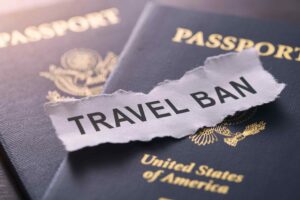Many of us travel to meet with friends and family during the holiday season. Although this should be a happy occasion, travel can be stressful –– especially for immigrants navigating US ports of entry or dealing with US immigration denied entry concerns.

As a permanent resident, you’re certain to encounter Customs and Border Protection (CBP) officers upon returning to the US through a port of entry. They’ll inspect your travel documents and determine whether you are a “returning resident” or an “arriving alien.” If you have a valid green card, you’ll likely be admitted immediately and granted entry. However, there’s a chance you’ll be taken to a separate area for “secondary inspection” at the CBP land border crossing if CBP is uncertain about your immigration status.
What to Expect in Secondary Inspection
Secondary inspection, an aspect of border security, can be frustrating and feel like an invasion of privacy. This process, governed by border search authority, can last anywhere from a few minutes to several hours, during which an officer will ask you US border questions, run record checks, and possibly take your fingerprints. CBP even has the authority to search your phone, tablet, laptop, or other electronic devices. They can read your emails, peruse your text messages, and check your social media feeds, illustrating the extensive border search authority. (This is why it’s important to protect your devices while travelling.)
Your Rights in Secondary Inspection
The good news is you have certain rights if you are detained by CBP in secondary inspection, a crucial part of border security procedures, including:
- The right to contact your consulate, which can assist you with contacting an attorney or family member, is a vital option if facing denied entry to the US.
- The right to ask to speak with your attorney, if you have one. (However, CBP may deny this request, a reality for those undergoing US customs questions scrutiny.)
- The right to review all paperwork presented by CBP, especially relevant for those concerned about US customs status or CBP case status.
- The right to refuse to sign any paperwork presented by CBP is a critical consideration for anyone worried about denied entry consequences.
We hope you will never be placed in a secondary inspection. If you are, ideally you will be processed quickly and granted entry, avoiding the complications of denied entry to the US.
Why CBP Might Be Suspicious of You – Even Though You Have a Green Card
However, CBP may consider you to be an “arriving alien” for several reasons, crucial for understanding the entry into the US and US entry requirements, including if they believe that you:
- Abandoned your permanent resident status
- Remained outside the US for six months without permission, impacting your US customs status
- Engaged in illegal activity abroad, which can affect your entry requirements for US citizens and lead to potential US immigration denied entry
If CBP believes you abandoned your permanent resident status, they may try to convince you to sign something called Form I-407, Record of Abandonment of Lawful Permanent Resident Status, a significant document in the context of US entry requirements and requirements to enter the United States.
Do Not Abandon Your Green Card
CBP cannot force you to sign Form I-407 or abandon your green card. You have the right to refuse to sign Form I-407 and request a hearing, a crucial step in protecting your rights as a US permanent resident. You will remain a permanent resident unless an immigration judge issues an official order of removal, a serious concern under the US denied entry policies.
To avoid possible delays, a concern for those navigating CBP ports of entry and US port of entry airports list, we strongly encourage you to speak with an experienced immigration attorney before making any travel plans. This is especially important for understanding the temporary foreign worker definition, the green card port of entry question, and broader US entry requirements for US citizens. Do you have questions or concerns about travelling as a permanent resident, possibly facing denied entry to US scenarios, or navigating CBP questions? Give us a call at (503) 427-8243 or schedule a consultation, essential steps for ensuring your entry into the US is as smooth as possible, whether you’re dealing with CBP secondary inspection experience or US customs questions and answers.







